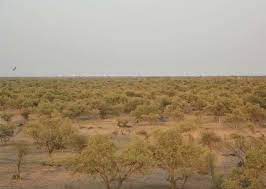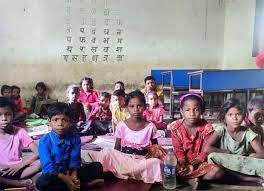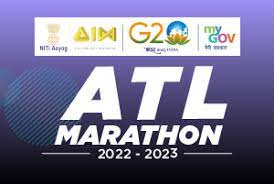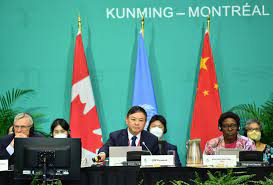Today’s Current Affairs: 21st December 2022 for UPSC IAS exams, State PSC exams, SSC CGL, State SSC, RRB, Railways, Banking Exam & IBPS, etc
Table of Contents
Oran land:

Residents from around 40 villages of Jaisalmer, Rajasthan have walked 225 kilometers to protect community-conserved sacred spaces known as ‘orans’.
- Currently, the biodiversity hotspots are classified as wastelands.
- The current categorization is causing a loss of biodiversity and is affecting the livelihood of the locals in the area, as huge chunks of land are being allotted for setting up solar plants.
- Thus need to recategorize the area as ‘oran land’.
- The orans are among the last natural habitats of the great Indian bustard
- The open stretch of land, which receives long hours of sunlight and brisk winds, has become a hub of green energy with windmills and solar photovoltaic dotting
- There are other orans like Mokla, Salkha, Kemde, which also spread across several hectares but are listed as wastelands
- These orans are hotspots of biodiversity with trees and flowers like rohida, bordi, kumbhat, and desi babool in large numbers.
Gloom In The Classroom: The Schooling Crisis In Jharkhand

Following the pandemic, attendance of students in Jharkhand schools dropped to 58 per cent at the upper primary level and 68 per cent at the primary level, according to a survey ‘Gloom in the Classroom: The Schooling Crisis in Jharkhand’ conducted by Gyan Vigyan Samiti Jharkhand.
- The report, prepared by economist Jean Dreze and researcher Paran Amitava slammed “decades of state apathy” towards education in the state and said it was “both a mistake and an injustice”.
Key findings of the report:
- The survey showed that underprivileged and tribal children were left abandoned by the Education Department.
- Out of the 138 schools surveyed for the report, 20 per cent had a single teacher.
- At 55 per cent, para-teachers (teachers who are not qualified to teach) accounted for the majority of teachers at the primary level in these schools. At the upper-primary level, the figure was 37 per cent.
- Not one of the schools surveyed had a functional toilet, electricity, or water supply.
- Around 66 per cent of the primary schools had no boundary wall, 64 per cent did not have a playground and 37 per cent had no library books.
- The majority of the teachers said that the school did not have adequate funds for the midday meals
District Mineral Foundation Scheme:

Odisha’s Keonjhar district is India’s highest recipient of funds under the District Mineral Foundation (DMF) scheme, and has spent ₹3,000 crore under the scheme over the past seven years.
- Keonjhar is hugely rich in mineral reserves, especially iron ore. The district has 2,555 million tonnes of iron ore available beneath its soil, of which approximately 50 million tonnes is extracted each year, a key driver of Odisha’s economy.
- As per the Mine and Minerals Development Regulation (Amendment) Act, 2015, in every district affected by mining-related operations, the state government shall, by notification, establish a trust as a non-profit body to be called the District Mineral Foundation.
- DMF Funds:Every mining lease holder of will pay a fraction of royalty, not exceeding one-third of the royalty, to the DMF as per rates prescribed by Central Government.
- This fund will be used for welfare of the people affected in the mining affected areas.
- In Keonjhar, the total DMF fund collection has touched an astounding ₹8,840 crore, the highest for any district in India.
- The idea behind the contribution is that local mining-affected communities, mostly tribal and among the poorest in the country, also have the right to benefit from natural resources extracted from where they live.
- The functioning of the DMF trusts and the fund use governed by states’ DMF Rules incorporate the mandates of a central guideline, Pradhan Mantri Khanij Kshetra Kalyan Yojana (PMKKKY).
India’s First-Ever Surety Bond Insurance Product:

Surety bond can be defined in its simplest form as a written agreement to guarantee compliance, payment, or performance of an act. Surety is a unique type of insurance because it involves a three-party agreement. The three parties in a surety agreement are:
- Principal: The party that purchases the bond and undertakes an obligation to perform an act as promised.
- Surety: The insurance company or surety company that guarantees the obligation will be performed. If the principal fails to perform the act as promised, the surety is contractually liable for losses sustained.
- Obligee: The party who requires, and often receives the benefit of the surety bond. For most surety bonds, the obligee is a local, state or federal government organization.
Advantages of the bond insurance:
- It will act as a security arrangement for infrastructure projects and will insulate the contractor as well as the principal.
- The product will cater to the requirements of a diversified group of contractors, many of whom are operating in today’s increasingly volatile environment.
ATL Marathon 2022-23:

NITI Aayog recently opened applications for ‘ATL Marathon 2022-23’.
- ATL Marathon is a flagship innovation challenge under Atal Innovation Mission’s Atal Tinkering Labs program.
- This is a national-level innovation challenge for young innovators across India who can solve community problems of their choice, and develop innovative solutions in the form of working prototypes or, minimum viable product (MVP).
- The theme for this edition of ATL Marathon is “India’s G20 Presidency”.
- AIM has designed the problem statements based on G20’s working group inspiring recommendations on internationally relevant issues in respective areas of focus.
- This marathon will create a huge opportunity for students to innovate not just for the better India but for the world by resolving global problems in various sectors.
Atal Tinkering Lab:
- Vision: To cultivate one Million children in India as Neoteric Innovators Atal Innovation Mission is establishing Atal Tinkering Laboratories (ATLs) in schools across India.
- Objective: To foster curiosity, creativity, and imagination in young minds; and inculcate skills such as design mind-sets, computational thinking, adaptive learning, physical computing etc.
- In order to foster inventiveness among students, ATL can conduct different activities ranging from regional and national level competitions, exhibitions, workshops on problem solving, designing and fabrication of products, lecture series etc. at periodic intervals.
Kunming-Montreal Global Biodiversity Framework:

The 15th Conference of Parties (COP15) to the UN Convention on Biological Diversity (CBD) adopted the Kunming-Montreal Global Biodiversity Framework (GBF) on December 19, 2022.
Kunming-Montreal Global Biodiversity Framework (GBF):
- The framework has 23 targets that the world needs to achieve by 2030.
- The countries will monitor and report every five years or less on a large set of indicators related to progress.
- The Global Environment Facility has been requested to establish a Special Trust Fund to support the implementation of the Global Biodiversity Framework (“GBF Fund”).
Key provisions:
- Countries committed to protecting 30% of land and 30% of coastal and marine areas by 2030, fulfilling the deal’s highest-profile goal, known as 30-by-30.
- The deal also aspires to restore 30% of degraded lands and waters throughout the decade, up from an earlier aim of 20%.
- And the world will strive to prevent destroying intact landscapes and areas with a lot of species, bringing those losses “close to zero by 2030”.
Carbon Markets:

The Energy Conservation (Amendments) Bill, 2022, passed by the Rajya Sabha recently, has several significant features. It will foster a carbon market in India, through the creation of a National emissions trading system (National ETS).
- Article 6 of the Paris Agreement provides for the use of international carbon markets by countries to fulfil their nationally determined contributions (NDCs).
- Carbon markets are essentially a tool for putting a price on carbon emissions— they establish trading systems where carbon credits or allowances can be bought and sold.
- A carbon credit is a kind of tradable permit that, per United Nations standards, equals one tonne of carbon dioxide removed, reduced, or sequestered from the atmosphere.
- Carbon allowances or caps, meanwhile, are determined by countries or governments according to their emission reduction targets.
- A United Nations Development Program released recently noted that interest in carbon markets is growing globally, i.e, 83% of NDCs submitted by countries mention their intent to make use of international market mechanisms to reduce greenhouse gas emissions.
Carbon markets:
There are broadly two types of carbon markets:
- compliance markets : set up by policies at the national, regional, and/or international level— are officially regulated
- voluntary markets : Voluntary markets are those in which emitters— corporations, private individuals, and others— buy carbon credits to offset the emission of one tonne of CO 2 or equivalent greenhouse gases.
INS Vagir:

The fifth submarine of the Project – 75, Kalvari Class submarines, Yard 11879 was delivered to the Indian Navy on December 20, 2022.
INS Vagir:
- Vagirwas launched into water on November 12, 2020 and commenced sea trials on February 1, 2022.
- It is having “superior stealth features” like advanced acoustic absorption techniques.
- The sixth and last of the Scorpène-class submarines, Vagsheer, was launched into water in April 2022 and is expected to be delivered to the Navy by end 2023.
- Six Scorpene submarines are being built under Project-75 by MDL under technology transfer from Naval Group of France under a $3.75 billion deal signed in October 2005.
- The project is about four years behind schedule.
- The first submarine INS Kalvariwas commissioned in December 2017, second submarine INS Khanderi in September 2019, third one INS Karanj in March 2021 and the fourth one INS Vela joined service in November 2021.




